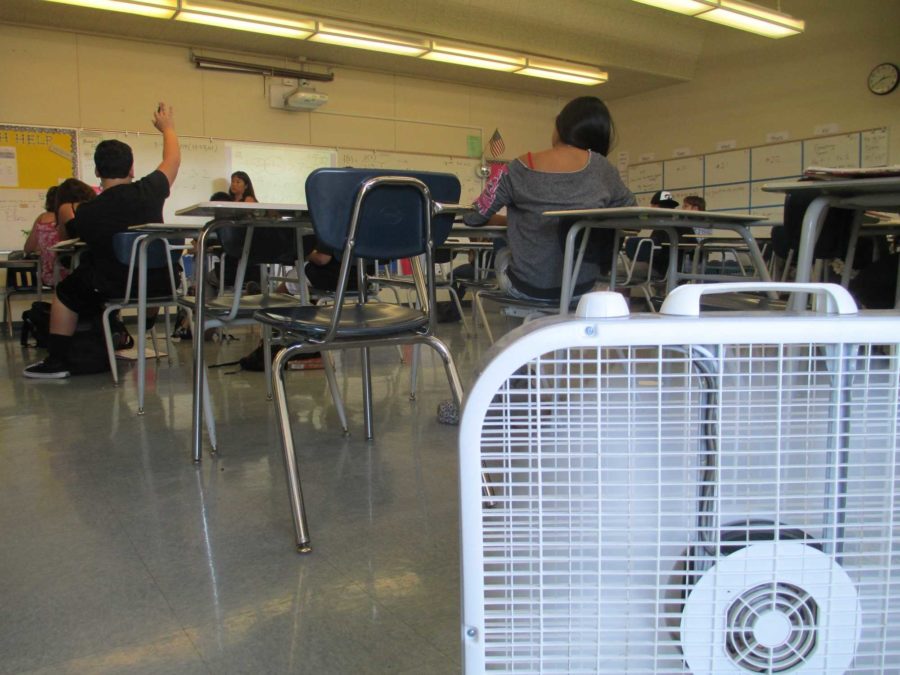Turning up the heat on Camarillo
Mrs. Katie Frederick teaches as her two fans guard the classroom’s entrance in an attempt to combat rising temperatures.
Hot classrooms, twitter accounts that call for “putting the AC back in ACHS”, and a misread of the 2004 Williams Act Settlement have increased interest into solutions for the high temperatures of Cam High indoor facilities. During hot and dry conditions normal during late summer and early fall, classroom temperatures often exceed 85 degrees and go as high as 100 degrees Fahrenheit.
According to the Williams lawsuit, students should not suffer from “inadequate, unsafe, and unhealthful school facilities such that the student attends classes in one or more rooms in which the temperature falls outside of the 65-80 degrees Fahrenheit range.”
However, the Williams settlement only requires these temperatures to be held in schools with already “existing […] air-conditioning systems.”
“The Williams Act is only focused on repairs to existing facilities. Schools are not required to install air conditioning, and Oxnard Union High School District is not in violation of the Williams Act,” said Mrs. Mary Ann Larrieu, Energy Conservation Specialist at OUHSD. “We care deeply about our students and staff, and […] we are taking ongoing proactive measures to monitor temperatures in classrooms at ACHS as well as our other schools.”
Additionally, even if the standards established by Williams were applicable, they are not enforced at Cam High due to its ranking as a decile 10 high school.
All high schools in California are divided into 10 equal ranks, or deciles, based on their API score, with decile 10 as the highest and decile 1 the lowest. Only schools in deciles 1-3 received the $800 million “facility repair” funding by the state and are required to be annually reviewed by the county superintendent.
Cam High’s API score of 869 for the 2013-2014 school year ranked it among the top 10% of California high schools, and therefore was ineligible for the additional funds and oversight.
The district has expressed awareness of the discomfort caused by the heat and is taking measures to solve the issue. “I realize that this is a sensitive issue, and we are doing all we can to provide a comfortable and productive learning environment,” read an email sent to all OUHSD teachers and staff on behalf of Dr. Gabe Soumakian, district superintendent. “We will be providing additional fans to site principals, which will be available to you upon request.”
Under Williams, members of the community can file facility complaints at the school with the school principal. If the complaint is out of the principal’s authority, he or she is required by law to forward the complaint to the school district within 10 working days. Emergency or urgent health and safety threats that should be reported include “nonfunctioning heat […] or air-conditioning systems,” states the guidelines posted under the California Department of Education.
As the demand for proper air conditioning heightens, Cam High’s budget and allotted funds remain scarce.
During the 2008-2009 school year, Cam High was granted $51,387 in funds to improve systems including plumbing, electrical, heat, and air-conditioning. However, the money was focused on repairing existing systems rather than building new ones, as recorded in Cam High’s School Accountability Report Card of that year.

Hello hello, the name is Amy, and this is my third year working for this beloved publication. Unsurprisingly, I love to read and write, but perhaps some...

















































































![Senior Ditch Day... Relaxation or Truancy? [Video]](https://achsstinger.com/wp-content/uploads/2017/10/IMG_7119-900x599.jpg)
![Heavy Rain Hits Cam High [video]](https://achsstinger.com/wp-content/uploads/2017/02/maxresdefault-900x506.jpg)




A Concerned Student • Oct 9, 2014 at 11:27 pm
Though you think the district is trying to help, let me ask you this. Why can our school budget afford a swimming pool on campus but not afford air conditioning. I’ve seen teachers pay their own money from their fans that help the two to three students sitting right next to it. I know these orders don’t come from the school or Mr. Lipman, but instead the District. This is why I blame the Oxnard Union High School District. Its blatantly obvious that they care more about our sports teams then the students well being. A Pool helps a small percentage of students, while an Air Conditioning System helps us all.
Concerned Parent • Oct 4, 2014 at 8:02 am
“During hot and dry conditions normal during late summer and early fall, classroom temperatures often exceed 85 degrees and go as high as 100 degrees Fahrenheit.” It would be helpful to provide actual data. I doubt a room was ever 100 degrees. How often and by how much has 85 degrees been exceeded? Historically, it is very rare (on the order of 1 in 100) for the weekly average temperature to exceed 85 degrees in Camarillo.
adviser • Oct 6, 2014 at 2:02 pm
The Stinger replies: If you look at this info and data: http://www.weather.com/weather/monthly/93012 You will see that while the average temperature in Camarillo through the years this time of year is about 78 degrees, that’s the average–and the highs in October regularly exceed 90 degrees (see records on linked data). The Stinger can confirm that during a total of 4 weeks of school this year, more than 20 classrooms on campus recorded temperatures inside above 90 degrees. Those are the facts.
ACHS student • Oct 7, 2014 at 12:12 am
Trust me– it has gotten to 100 degrees atleast plenty of times. As a student with 3 classes in the C building, where there are windows only on one side of the clasroom and rarely a cool breeze to be felt, i can attest that is totally possible and has happened more than a few times this year. Its not just the outside temperature that affects it, the classroom temperature is considerably warmer since there are 30+ sweating bodies in a confined space.
Luis Espinosa • Oct 2, 2014 at 10:21 pm
Somewhere, there is a breakdown. Camarillo boasts one of the most fiscally sound communities in the state. The City recently reported a nearly 8 million dollar surplus in their annual budget. So, the tax payers are doing their part. The Teachers are doing their part. The students are doing their part. Why don’t we work on getting District officials, City leaders, administrators, to step up, think outside the box, and provide the learning environment our community deserves! The quotes we should be hearing from officials is “This is unacceptable”.